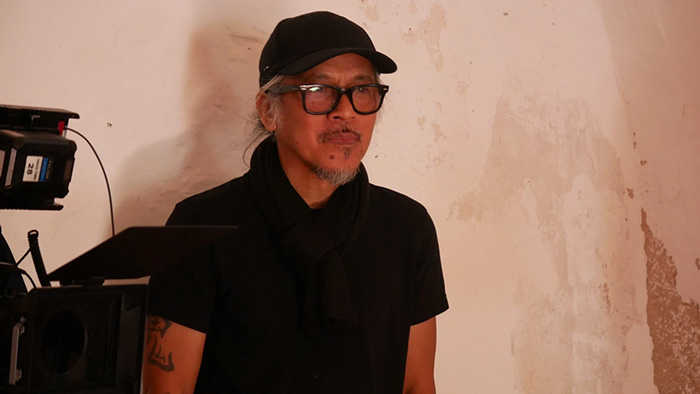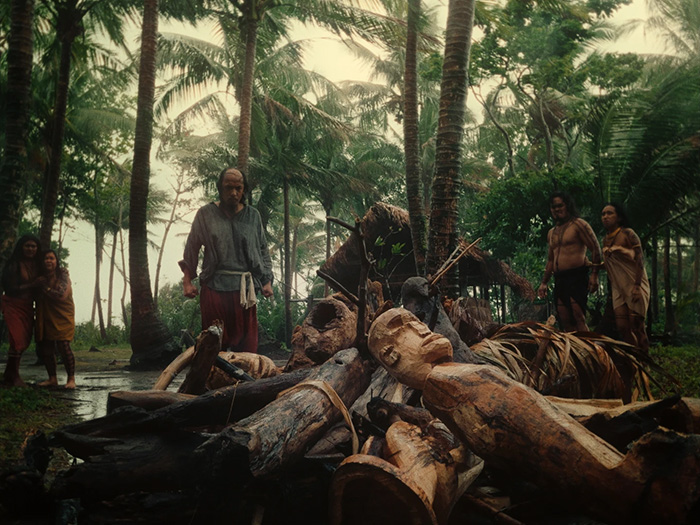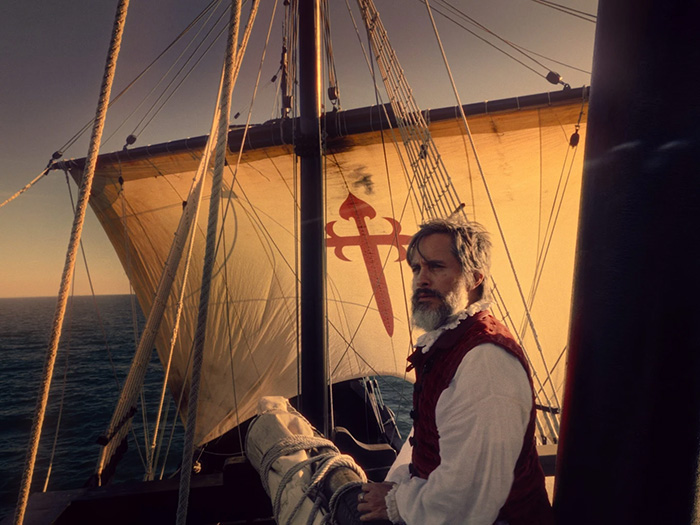‘Magellan’ cast offers a glimpse into Lav Diaz’s Cannes 2025 historical epic
Filipino auteur Lav Diaz returned to the Cannes Film Festival as Magellan (Magalhães), his historical opus on the famed Portuguese explorer, starring Mexican actor Gael García Bernal, debuted at the Cannes Premiere Selection of the 78th edition of the renowned spring festival.
Magellan is already the Filipino director’s third film at Cannes. Six years ago, his dystopian thriller Ang Hupa premiered in the Directors’ Fortnight section, while the 2013 psychological drama Norte, Hangganan ng Kasaysayan screened in the Un Certain Regard section.
The Cannes title, following Norte, is also the latest addition to Diaz’s rare catalogue of films shot in color. It was first revealed in 2019 under the working title Beatriz, The Wife, with Diaz’s intention to draw focus on the story of the navigator’s wife, María Caldera Beatriz Barbosa.
Retitled Magellan, the story, or at least the 156-minute cut that screened at Cannes as Diaz plans to release a nine-hour version of the movie, chronicles Ferdinand Magellan’s colonial campaigns in the early 16th century and demise in the Philippine archipelago, balancing the Western and Malay perspectives. The film was shot across the Philippines, Portugal, and Spain.

“It’s not learning history, it’s feeling history,” actress and production manager Hazel Orencio tells PhilSTAR L!fe, when asked about how the retelling veers off previous cinematic iterations of Magellan’s expedition. “It’s [incorporating] Malay history into world history,” she continues. “It’s not just Magellan’s history. It’s not just Magellan’s pursuit. It’s our representation.”
Actor Amado Arjay Babon affirms his co-star’s insights, recognizing the extra amount of effort that Diaz put into his research. In fact, mountains of books crowd Diaz’s workspace; at times, he even sleeps with them.
“Grabe talaga ‘yong commitment ni Sir Lav dito,” he says. “Kasi pwede namang ‘yong history parang i-change vessel lang niya sa cinema. Pero nag-effort pa siya to investigate it.”
Babon adds, “I think that’s the best aspect of the film, na hindi mo lang siya cinopy-paste from history. But it’s more of investigating and trying to [understand] kung paano siya magkakaroon ng sense sa contemporary lives natin as Filipinos.”
As Juana and Enrique
In the film, Orencio plays Juana, the wife of Cebu chieftain Rajah Humabon, portrayed by Ronnie Lazaro. Babon, meanwhile, takes on the role of Enrique, the Malay slave to Magellan.
Both actors admitted that they struggled with the languages used in the film, as it migrated between Portuguese, Spanish, Tagalog, and Bisaya. They even had to try Duolingo, an online language learning tool, to learn Portuguese, but eventually got some guidance from the Portuguese assistant directors involved in the production.
“Lalo na ‘yong emotional scenes with Ronnie,” Orencio says, noting how difficult it was for her to code-switch to Bisaya as an Ilonggo. “Naku, hirap na hirap ako. There were times na talagang parang nag-give up na ako sa sarili ko. Napi-pressure ako kasi ang kaeksena ko ba naman si Ronnie saka si Bong Cabrera na parehong fluent sa Bisaya. May times na, ‘Hala, kaya ko ba ‘to, Lav?’”
This, on top of the fact that the character is pivotal in the story. Juana, first known as Hara Humamay, became a significant figure in the conversion of Cebu, and eventually the Philippines, to Christianity. Magellan also gifted her the Santo Niño, a symbol of the Christian faith.

That Orencio was in charge of the production’s Philippine leg also added pressure. “The last time we were this many was in 2016 when we did Hele sa Hiwagang Hapis dahil ang dami talaga nun,” she recalls. “Ang daming problema sa prod. And then I have to study my lines. I have to study Bisaya. At one point sinabi ko, ‘Lav, kuha ka na lang kaya ng iba?’”
Babon shared that experience, but he was also up to the task. “Given [na si] Sir Lav na pagbigay sa ‘yo nung script, hindi mo pa alam ‘yong arc ng character, so I just follow it,” he says. “Just trust the text, the narrative. Don’t anticipate, don’t overthink, don’t over-prepare. Just follow what’s there and then suddenly magme-make sense lahat.”
When the role was offered to him, Babon, who used to teach social studies in high school and college, assumed a bigger onus, given the clashing discourse on Enrique de Malacca. “Isa siya sa mga kasama sa expedition pero isa siya sa mga obscure,” he explains.
“Hindi nga siya matanggap ng kasaysayan natin na siya ‘yong pinakaunang taong nakalibot sa mundo,” he continues. “Because we are nailed, nakapako tayo sa idea na kung anong nakasulat, ‘yon lang ang totoo. So ‘yon ang challenge na paano mo siya mabibigyan ng pagkakataon na mas makita siya, mas magnified siya sa kasaysayan natin sa pamamagitan ng pelikula.”
Babon is also fascinated with the fact that Enrique is a polyglot, sharing how the movie, beyond depicting the character as a slave, heightens that kind of power that the voyage’s spiritual shaman could weaponize against the colonizers.
Theater roots
Both Orencio and Babon had backgrounds in theater, and it factored into the process of crafting the characters they portrayed.
For Babon, what he brought to the role was an accumulation of his experiences, from his first foray into community theater in Tacloban, learning from his late mentor, the playwright and educator Joey Lianza, until he became a scholar at Tanghalang Pilipino.
“Rather than performing as an actor, it’s more of a communal experience,” he explains. “Kaya nung pinagawa ito ni Sir Lav, parang I’m just too familiar with what I’m doing, speaking to nature, speaking to the spirits.”
For Orencio, though, it’s all about learning everything. “From being a props person, wardrobe person, lahat, aralin mo talaga,” she says. “‘Yong idea na pantay-pantay kayong lahat. There are no small roles.”
That theater culture bleeds into Sine Olivia Pilipinas, Diaz’s film production house. “Kahit si Lav, he will make you feel na importante ka,” the actress adds. “Hindi ka utility [worker] lang, hindi ka setman lang. Lahat will feel valued. Kapag naaalala ko ‘yong ganong proseso sa teatro and then ‘yong proseso namin ngayon, it doesn’t feel like umalis ako ng teatro at all.”
It also helped that the foreign members of the cast got their start through theater. “Maganda talaga makipag-work sa mga taga-teatro kasi may iba kayong uniberso kahit iba ‘yong kultura niyo,” Orencio says. “Basta taga-teatro, nagkakaintindihan kayo. You have your language, tinginan pa lang. May warmth na parang close kayo agad kasi nga you’re from theater.”
A Mexican star on set

Since the gestation period of Magellan, Bernal has been hands-on. It was producers Joaquim Sapinho and Albert Serra who first considered Bernal for the titular role, eventually meeting up with the actor in Berlin, Germany. Later, Diaz and Bernal had a meeting in Lisbon, Portugal, and immediately hit it off.
On set, Orencio says that Bernal is unforgiving of himself. “From Europe hanggang dito, once he’s in costume, in character na siya,” she explains. “Tapos mag-space out na siya, then he rehearses. Medyo malupit siya sa sarili niya kasi practice din siya nang practice with his lines, with our Portuguese assistant directors, kasi he wants to make sure na tama ‘yong pronunciation niya, tama ‘yong phrasing niya.”
The Mexican star, adds Orencio, would even ask for more takes just to perfect his lines. “Very meticulous at very conscious si Gael, since hindi rin naman niya mother tongue ang Portuguese. Nag-aral din siya. Mas Spanish-speaking talaga siya. And ‘yong Portuguese pala na ginamit for the film is parang old Tagalog.”
Babon, on the other hand, shares how focused Bernal is as an actor, recounting how the lead star even called his attention after he was seen filming on his phone during rehearsals. “[That’s what] I admire the most kay Gael kasi he’s an honest actor. Kahit hindi pa nagti-take, andun na siya sa focus, sa state, na ‘yon.”
Experiential cinema
Among the encounters that Orencio and Babon find particularly memorable is the production’s European leg, when they filmed in the renovated Victoria, Magellan’s ship that returned to Spain, which is now a moving museum stationed on the Cadiz shore.
Members of the cast and crew even had to take some kind of antiemetic drug just to stave off the motion sickness. “Natatawa ako doon kasi ‘di ba sukang-suka na ako,” Babon recounts to L!fe. “Tapos ‘pag magpi-pills naman, antok naman ako. Nandun ako sa silong. Sabi ko, ‘si Sir Lav, ba’t hindi natatablan?’ Hindi siya nag-take ng pills.”
Diaz then told his actor, “Mga Bisaya tayo ‘di ba?” alluding to how the Bisaya people are accustomed to living and thriving around bodies of water. Babon says he was enlightened at the moment.
“Anyone who would ride that ship,” Orencio chimes in, “talagang mahihilo kasi wobbly talaga siya. Doon ko na-appreciate na hindi ‘to parang superferry na stable. Pero okay lang ‘yon kasi parang it helps us, lalo si Arjay with feeling his character kasi imagine kung ganun ‘yong barko na sinakyan nila. Paano nila na-survive ‘yon? And ilang araw, ilang buwan, ilang taon silang nandoon.”
Diaz’s cinema, by Orencio’s observation, is just as experiential as that. “It’s more of mararamdaman mo,” she says. “After watching it, magkakaroon ka ng better understanding of history at kung bakit ganito tayo ngayon. Hindi lang the Filipino society, but the whole world. Bakit tayo ganun? Because may pinanggalingan back in 1521. So may deeper insight on history.”
“Feeling ko ‘di mo maa-approximate sa words,” Orencio continues. “Even ‘yong experiences namin, nahihirapan kami ni Arjay. Ang dami-dami naming gustong ikuwento. It’s a shared experience na parang kulang talaga ‘yong salita. And what more sa film?”


